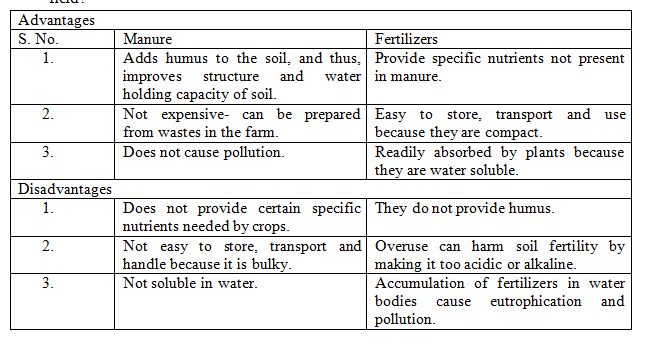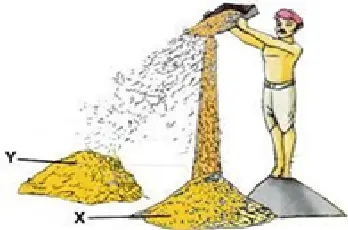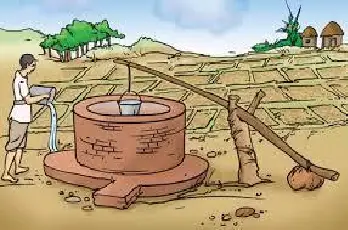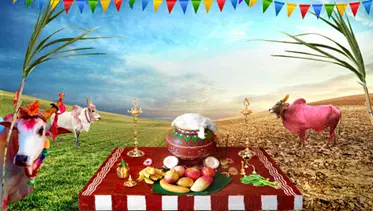

Welcome to class 8 science chapter 1 question answer. On this page you would find a question bank of important HOTs and Long answer type questions along with their answer. These questions are generally 3 marks or 5 marks questions.
To see answer to the questions just click the answer button and the drop-down would have the answer.
This question and answer page is prepared as per NCERT book and is as per CBSE specifications.
Answer the following class 8 science crop production and management questions.
Question 1. Differentiate between kharif and rabi crops with two example of each?
Difference between kharif and Rabi crops:
Kharif crops are those crops that are planted at the start of the rainy season, typically between April and May.
Rabi crops are those crops that are that are planted at the end of the monsoon season or at the start of the winter season, typically between September and October.
Crops grown during the Kharif and Rabi seasons include:
Wheat, barley, oats, gramme, mustard, and linseed are Rabi crops.
Rice, maize, millet, ragi, pulses, soybeans, and groundnuts are kharif crops.
Question 2 How is leveling different from tilling and write the significance of these processes?
Tilling is the technique of loosening and mixing the soil to make it easier to sow seeds, while levelling is the process of levelling the surface of the soil after tilling to ensure that no lumps remain in the soil. Tiling is done to aerate the soil and mix the nutrients in the soil, and levelling is done to ensure that no lumps remain in the tilled soil, which might impede plant growth.
Question 3. What are weeds and how do weed affect crops?
Weeds are plants that are unwanted in cultivated fields. They compete for food, space, and light with crop plants. They eat the nutrients and slow the crop's growth.
Question 4. What is hybridization?
Hybridization is the process of combining two or more different species of plants, animals, or other organisms to generate a new and improved organism with the qualities of both the original organisms.
Question 5. Explain nitrogen cycle?
The nitrogen cycle refers to the process by which nitrogen moves from the atmosphere to the soil and organisms before being released back into the atmosphere. It is the process by which atmospheric nitrogen gets transformed into a form that can be easily absorbed by Earth's organisms.
Question 6. What is nitrogen assimilation?
It is the process by which organic nitrogen compounds like amino acids are made from inorganic nitrogen compounds that are found in the environment. Those organisms, such as plants, fungi, and certain bacteria, that are unable to fix nitrogen gas (N2) rely on their ability to assimilate nitrate or ammonia to meet their nutritional requirements.
Question 7. What is animal husbandry?
Animal husbandry is the breeding, feeding, and care of domestic animals for food and other reasons.
It includes rearing animals that produce meat or eggs, such as goats, poultry animals (such as chickens, ducks, and turkeys), fish, and sheep.
Animals that provide milk, such as cows, buffaloes, goats, and camels are also reared.
Question 8. List the steps involved in crop production?
Steps involved in crop production in sequential order are
Question 9. What are the advantages of ploughing the soil before sowing seeds?
Ploughing is a technique for loosening soil in preparation for agriculture. Ploughing is used to turn over the top layer of soil. It aids in the transport of new nutrients to the surface. It also aids in the burial of weeds and previous crop wastes.
Advantages of Ploughing
Question 10. What precautions should be kept in mind while sowing seeds in a field?
Precautions to be kept in mind while sowing seeds in a field are
Question 11. Why is crop rotation considered a good agricultural practice?
Crop rotation is the practice of cultivating a variety of crops in the same location over the course of several seasons. It is done so that farm soil is not exploited for only one type of fertilizer. It aids in soil fertility and crop productivity by minimizing soil erosion.
Question 12. How would you prepare yous field before sowing seeds?
Preparation of soil involves ploughing and lavelling it. Ploughing involves loosening and turning of soil using a tool or an implement called the plough made up of wood or iron. They are either drawn by bullocks or by tractors. The ploughed soil often has crumbs of soil that need to be crushed and the soil lavelled. This is achieved using a leveller.
Question 13. Why is it essential to irrigate our fields?
A good crop yield requires availability of the right amount of water. Minerals and fertilizers can only be absorbed by the plants in presence of water. Seeds do not germinate in the absence or scarcity of water. Hence, agricultural fields needs to be irrigated or watered regularly.
Question 14. Compare the benefits and disadvantages of using manures and fertilizers in the crop field?

Question 15. Why continuous plantation of the same crop in the field should be avoided?
Different cops have different nutrient requirements. If you grow the same crop in the same field season after season, the soil becomes deficient in the set of nutrients needed by the crop. So it is better to grow one crop in one season and another crop in the next season. This is done by crop rotation method.
Answer the following questions (HOTS) for class 8 chapter 1 crop production and management that is about agriculture.
Question 1. Out of manure and fertilizers which one do you think is appropriate for soil? Why?
Manure is better, as it is organic substance, rich in organic nutrients, not harmful, prevents soil pollution.
Question 2. Rakesh was preparing to produce crops and was making the list of agricultural practices: he included the following in the list-
Which agricultural practice is missing from the above list?
Harvesting is missing.
Question 3. If wheat is sown in the kharif season, what would happen? Discuss.
The kharif season is not suitable for growth of wheat, the whole crop might get destroyed because of lack of optimum temperature, adaptability, availability of pests, etc.
Question 4. Why do you think field fallow is important?
It restores the fertility of the soil, prevents leaching of soil nutrients.
Question 5. Which method of irrigation is suitable for Rajasthan? Why do you think so?
Drip irrigation. It is effective in terms of saving water so as Rajasthan is a region of water scarcity this method is suitable.
Question 6. Given below is an image. Study it and answer the following questions:

i. What is X and Y? ii. Identify the process. iii. Give one importance of it.
i. X-seed , Y- chaff
ii. Winnowing
iii. This process will separate the seed from chaff.
Question 7. State the disadvantages of hybridization technique.
Crops may provide less fodder, require more amount of fertilizers, weedicides, and pesticides.
Question 8. Given below is an image. Study it and answer the following questions:

i. Identify the type of irrigation.
ii. Is it a traditional or modern method
iii. How does this method of irrigation work?
i. Dhekli
ii. Traditional method
iii. This irrigation is done manually. The person had to take out water using bucket and pour it into the field. This is not very efficient method.
Question 9. A farmer was very worried as the salt content has increased in soil and was harming the crops. what could be the reason for it, even though he was not spraying salty salt?
The water for irrigating the field contained high salt concentration, which increased the salt concentration in soil.
Question 10. why do farmers release ladybirds in gardens?
It is because they can eat up the pest, and thus protect the plants, also they do not harm the crop plants.
Question 11. Arrange the following process in correct sequence.

3,2,1
Question 12. Why is it necessary to dry grains before storing them?
Presence of moisture promotes microbial growth in the grains. Hence it should be dried before storing.
Question 13. “Excessive irrigation harmful to the crops” Justify?
It decreases the amount of air available to the roots and increases the salt content of the soil.
Question 14. Explain how soil gets affected by the continuous plantation of crops in a field?
Plants absorb their mineral nutrients from soil. Repeated growing of crops in some field
makes the soil poorer of nutrients. This reduces soil fertility and so crop production would be poor.
Question 15. Suraj has sown the seeds too deep. What does he likely going to observe? Give reasons.
The seeds may not grow due to insufficient air.
Question 16. Why sowing seeds with seed drill is better than broadcasting?
Seed drill sows the seeds uniformly at proper distances and depths, whereas broadcasting of seeds scatter them non-uniformly on the ground surface which can be easily eaten by birds.
Question 17. As a biology lab work, Riya had sown, some seeds in the soil and watered them by drip irrigation. She was asked to observe daily by her biology mam.
(i) Does this technique can save water?
(ii) What changes in the seed would be observed by Riya?
(i)Yes, it can save water. The drip system is a better manager of water.
(ii) Riya will observe that seed begins to germinate.
Question 18. Why pea is sown after wheat?
Wheat uses lot of nitrogen from soil, as pea is a leguminous plants it contains nitrogen-fixing bacteria in their roots that help in restoring nitrogen content of the soil.
Question 19. Identify the festival shown below:

Name the festival shown.
Name the agricultural process for which it is celebrated?
Pongal Harvesting
Question 20. Why does the soil need levelling?
It prevents the top fertile soil from being carried away by strong winds or washed away by rain water, also helps in the uniform distribution of water in the fields during irrigation.
This Class 8 Science Chapter 1 Question Answer Sheet is prepared keeping in mind the latest syllabus of CBSE . This has been designed in a way to improve the academic performance of the students. If you find mistakes , please do provide the feedback on the mail.